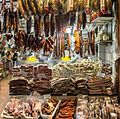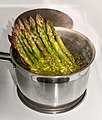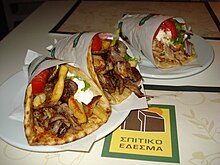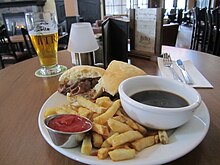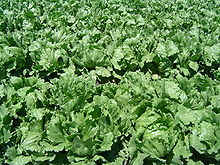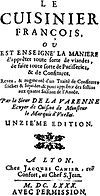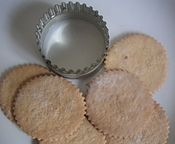Portal:Food
F o o d
A portal dedicated to food and foodways
Introduction
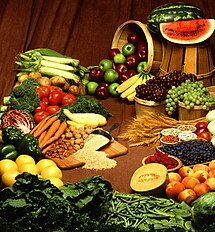
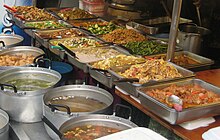
Food is any substance consumed by an organism for nutritional support. Food is usually of plant, animal, or fungal origin and contains essential nutrients such as carbohydrates, fats, proteins, vitamins, or minerals. The substance is ingested by an organism and assimilated by the organism's cells to provide energy, maintain life, or stimulate growth. Different species of animals have different feeding behaviours that satisfy the needs of their metabolisms and have evolved to fill a specific ecological niche within specific geographical contexts.
Omnivorous humans are highly adaptable and have adapted to obtain food in many different ecosystems. Humans generally use cooking to prepare food for consumption. The majority of the food energy required is supplied by the industrial food industry, which produces food through intensive agriculture and distributes it through complex food processing and food distribution systems. This system of conventional agriculture relies heavily on fossil fuels, which means that the food and agricultural systems are one of the major contributors to climate change, accounting for as much as 37% of total greenhouse gas emissions. (Full article...)
Cooking, also known as cookery or professionally as the culinary arts, is the art, science and craft of using heat to make food more palatable, digestible, nutritious, or safe. Cooking techniques and ingredients vary widely, from grilling food over an open fire, to using electric stoves, to baking in various types of ovens, reflecting local conditions. Cooking is an aspect of all human societies and a cultural universal.
Preparing food with heat or fire is an activity unique to humans. Archeological evidence of cooking fires from at least 300,000 years ago exists, but some estimate that humans started cooking up to 2 million years ago.
The expansion of agriculture, commerce, trade, and transportation between civilizations in different regions offered cooks many new ingredients. New inventions and technologies, such as the invention of pottery for holding and boiling of water, expanded cooking techniques. Some modern cooks apply advanced scientific techniques to food preparation to further enhance the flavor of the dish served. (Full article...)
Acquacotta (Italian: [ˌakkwaˈkɔtta]; lit. 'cooked water') is a hot broth-based bread soup in Italian cuisine that was originally a peasant food. Its preparation and consumption dates back to ancient history, and it originated in the coastal area known as the Maremma, in southern Tuscany and northern Lazio. The dish was invented in part as a means to make hardened, stale bread edible. In contemporary times, ingredients can vary, and additional ingredients are sometimes used. Variations of the dish include acquacotta con funghi and acquacotta con peperoni. (Full article...)
Selected article –
Gyros, sometimes anglicized as a gyro (/ˈjɪəroʊ, ˈdʒɪər-, ˈdʒaɪr-/; Greek: γύρος, romanized: yíros/gyros, lit. 'turn', pronounced [ˈʝiros]) in some regions, is meat cooked on a vertical rotisserie, then sliced and served wrapped or stuffed in pita bread, along with other ingredients such as tomato, onion, fried potatoes, and tzatziki. In Greece, it is normally made with pork or sometimes with chicken, whilst beef and lamb are also used in other countries. (Full article...)
Selected cuisine -
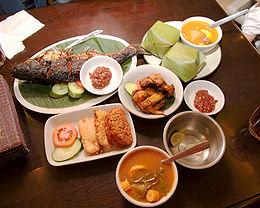
Indonesian cuisine is a collection of various regional culinary traditions that formed in the archipelagic nation of Indonesia. There are a wide variety of recipes and cuisines in part because Indonesia is composed of approximately 6,000 populated islands of the total 17,508 in the world's largest archipelago, with more than 1,300 ethnic groups.
There are many regional cuisines, often based upon indigenous culture with some foreign influences. (Full article...)
Selected ingredient –
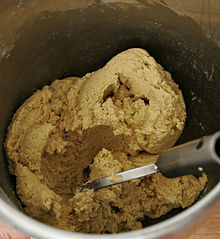
Dough is a thick, malleable, sometimes elastic paste made from grains or from leguminous or chestnut crops. Dough is typically made by mixing flour with a small amount of water or other liquid and sometimes includes yeast or other leavening agents, as well as ingredients such as fats or flavourings.
Making and shaping dough begins the preparation of a wide variety of foodstuffs, particularly breads and bread-based items, but also including biscuits, cakes, cookies, dumplings, flatbreads, noodles, pasta, pastry, pizza, piecrusts, and similar items. Dough can be made from a wide variety of flour, commonly wheat and rye but also maize, rice, legumes, almonds, and other cereals or crops. (Full article...)
Selected recipe –
A French dip sandwich, also known as a beef dip, is a hot sandwich consisting of thinly sliced roast beef (or, sometimes, other meats) on a "French roll" or baguette.
It is usually served plain but a popular variation is to top with provolone cheese, onions, and a dipping container of beef broth produced from the cooking process (termed au jus, "with juice"). Beef stock, a light beef gravy, or beef consommé is sometimes substituted. The sandwich is most commonly served with a cup on the side of the plate, into which the sandwich is dipped as it is eaten, although this is not how the sandwich was served when it was originally developed. (Full article...)
Lettuce (Lactuca sativa) is an annual plant of the family Asteraceae. It is most often grown as a leaf vegetable, but sometimes for its stem and seeds. Lettuce is most often used for salads, although it is also seen in other kinds of food, such as soups, sandwiches and wraps; it can also be grilled. One variety, celtuce (asparagus lettuce), is grown for its stems, which are eaten either raw or cooked. In addition to its main use as a leafy green, it has also gathered religious and medicinal significance over centuries of human consumption. Europe and North America originally dominated the market for lettuce, but by the late 20th century the consumption of lettuce had spread throughout the world. As of 2021[update], world production of lettuce and chicory was 27 million tonnes, 53 percent of which came from China.
Lettuce was originally farmed by the ancient Egyptians, who transformed it from a plant whose seeds were used to obtain oil into an important food crop raised for its succulent leaves and oil-rich seeds. Lettuce spread to the Greeks and Romans; the latter gave it the name lactuca, from which the English lettuce is derived. By 50 AD, many types were described, and lettuce appeared often in medieval writings, including several herbals. The 16th through 18th centuries saw the development of many varieties in Europe, and by the mid-18th century, cultivars were described that can still be found in modern gardens. (Full article...)
Selected image –

Selected biography –
B. 1618 – d. 1678
François Pierre de la Varenne (French pronunciation: [fʁɑ̃swa pjɛʁ də la vaʁɛn], 1615–1678 in Dijon), Burgundian by birth, was the author of Le Cuisinier françois (1651), one of the most influential cookbooks in early modern French cuisine. La Varenne broke with the traditions that had revolutionised medieval and Renaissance French cookery in the 16th century and early 17th century. (Full article...)
Did you know (auto-generated) –

- ... that Gleaners Food Bank has served more than 700 million pounds (320 million kg) of food in Indiana?
- ... that the operators of a Wisconsin radio station received unsolicited checks and food deliveries?
- ... that in 1776 Abraham Hunt entertained Hessian mercenaries with food and drink to render them incapable for duty the night before George Washington defeated them at Trenton?
- ... that because of the increasing prevalence of sesame allergy, the U.S. will join the EU and Canada in 2023 in instituting mandatory food labeling?
- ... that an investigation found that most Mexican nutrition science students could not interpret a nutritional front-of-package labeling system correctly?
- ... that the Unitized Group Ration – Express is designed to heat food itself without the need of a field kitchen?
More did you know –
Related portals
Food topics
The following are topics relating to food
Categories
Food list articles
- See also: Lists of foods and Category:Lists of drinks
The following are some Food list articles on Wikipedia:

- American cheeses
- Appellation d'Origine Contrôlée cheeses
- Apple cultivars
- Bacon dishes
- Bacon substitutes
- Basil cultivars
- Breads
- Breakfast beverages
- Breakfast cereals
- Breakfast foods
- British cheeses
- Cakes
- Candies
- Cheeses
- Cheese soups
- Christmas dishes (list)
- Cocktails
- Cookies
- Dishes using coconut milk
- Diets
- Doughnut varieties
- Egg dishes
- Fermented soy products
- Food additives
- Food additives (Codex Alimentarius)
- Foods named after people
- French cheeses
- French dishes
- Fried dough foods
- Fruits
- List of hamburgers
- Herbs and spices
- Hors d'oeuvre
- Indian dishes
- Indian snack foods
- Indonesian dishes
- Italian dishes
- Japanese snacks
- Japanese dishes
- Jewish dishes
- Kebabs
- Korean beverages
- Mango cultivars
- Moroccan dishes
- Pasta
- Pastries
- Philippine snack food
- Pies, tarts and flans
- Poppy seed pastries and dishes
- Potato dishes
- Puddings
- Raw fish dishes
- Rice dishes
- Rolled foods
- Sauces
- Seafood
- Seeds
- Sandwiches
- Snack foods
- Soft drinks by country
- Soul foods and dishes
- Soups
- Stews
- Street foods
- Tapas
- Turkish dishes
- Twice-baked foods
- Vegetable oils
- Vegetables
- Vodkas
Things you can do
Related WikiProjects
| Parent project: WikiProject Food and Drink | |
| Child projects: | Task forces: (All inactive) |
|
|
| Related projects: | |
New articles
Rules | Match log | Results page (for watching) | Last updated: 2024-10-23 19:15 (UTC)
Note: The list display can now be customized by each user. See List display personalization for details.
- Chicken breast steak with peach (edit | talk | history | links | watch | logs | tools) by Aaa000000 (talk · contribs · new pages (1)) started on 2024-10-23, score: 10
- Guapple pie (edit | talk | history | links | watch | logs | tools) by FromFrank (talk · contribs · new pages (2)) started on 2024-10-23, score: 20
- Reverend's BBQ (edit | talk | history | links | watch | logs | tools) by Another Believer (talk · contribs · new pages (72)) started on 2024-10-23, score: 10
- Roberto Gómez (baseball) (edit | talk | history | links | watch | logs | tools) by Ce Ele 415 (talk · contribs · new pages (2)) started on 2024-10-22, score: 10
- J-dag (edit | talk | history | links | watch | logs | tools) by Ser! (talk · contribs · new pages (2)) started on 2024-10-21, score: 10
- Food inflation in Iran (edit | talk | history | links | watch | logs | tools) by MelikaShokoufandeh (talk · contribs · new pages (1)) started on 2024-10-21, score: 10
- Environmental Land Management (edit | talk | history | links | watch | logs | tools) by Lionfish0 (talk · contribs · new pages (1)) started on 2024-10-20, score: 10
- Roy Dook (edit | talk | history | links | watch | logs | tools) by Pyeongchang (talk · contribs · new pages (9)) started on 2024-10-17, score: 10
- Sammich (restaurant) (edit | talk | history | links | watch | logs | tools) by Another Believer (talk · contribs · new pages (72)) started on 2024-10-20, score: 10
- Dalandan (edit | talk | history | links | watch | logs | tools) by TheNuggeteer (talk · contribs · new pages (7)) started on 2024-10-19, score: 10
- John Dewar & Sons (edit | talk | history | links | watch | logs | tools) by John baost (talk · contribs · new pages (5)) started on 2024-10-19, score: 10
- Polynesian curry (edit | talk | history | links | watch | logs | tools) by Poorman king (talk · contribs · new pages (1)) started on 2024-10-19, score: 20
- The Chef and the Daruma (edit | talk | history | links | watch | logs | tools) by Bearcat (talk · contribs · new pages (112)) started on 2024-10-18, score: 20
- Annona squamosa (edit | talk | history | links | watch | logs | tools) by MPF (talk · contribs · new pages (1)) started on 2024-10-18, score: 20
- Third-pound burger (edit | talk | history | links | watch | logs | tools) by Sushidude21! (talk · contribs · new pages (3)) started on 2024-10-18, score: 20
- Tyromancy (edit | talk | history | links | watch | logs | tools) by Jonathan Deamer (talk · contribs · new pages (10)) started on 2024-10-17, score: 10
- Biscotti di San Martino (edit | talk | history | links | watch | logs | tools) by OppidumNissenae (talk · contribs · new pages (9)) started on 2024-10-17, score: 30
- Cassatella di Agira (edit | talk | history | links | watch | logs | tools) by OppidumNissenae (talk · contribs · new pages (9)) started on 2024-10-16, score: 30
- Ossa di morto (edit | talk | history | links | watch | logs | tools) by OppidumNissenae (talk · contribs · new pages (9)) started on 2024-10-15, score: 30
- Saratoga Water (edit | talk | history | links | watch | logs | tools) by Wil540 art (talk · contribs · new pages (12)) started on 2024-10-15, score: 20
- Flora Food Group (edit | talk | history | links | watch | logs | tools) by Cloudbound (talk · contribs · new pages (1)) started on 2024-10-14, score: 40
- Suguru Fukuda (edit | talk | history | links | watch | logs | tools) by TSUBAME98 (talk · contribs · new pages (7)) started on 2024-10-14, score: 10
- Kenya Suzuki (edit | talk | history | links | watch | logs | tools) by TSUBAME98 (talk · contribs · new pages (7)) started on 2024-10-14, score: 10
- Kōta Tatsu (edit | talk | history | links | watch | logs | tools) by TSUBAME98 (talk · contribs · new pages (7)) started on 2024-10-14, score: 10
- Takahide Ikeda (edit | talk | history | links | watch | logs | tools) by TSUBAME98 (talk · contribs · new pages (7)) started on 2024-10-14, score: 10
- Tsubasa Nabatame (edit | talk | history | links | watch | logs | tools) by TSUBAME98 (talk · contribs · new pages (7)) started on 2024-10-14, score: 10
- Shōma Kanemura (edit | talk | history | links | watch | logs | tools) by TSUBAME98 (talk · contribs · new pages (7)) started on 2024-10-14, score: 10
- Taiki Narama (edit | talk | history | links | watch | logs | tools) by TSUBAME98 (talk · contribs · new pages (7)) started on 2024-10-14, score: 10
- Sure Shot Burger (edit | talk | history | links | watch | logs | tools) by Another Believer (talk · contribs · new pages (72)) started on 2024-10-13, score: 20
- Guasteddra (edit | talk | history | links | watch | logs | tools) by OppidumNissenae (talk · contribs · new pages (9)) started on 2024-10-13, score: 30
- Wuliangye (spirit) (edit | talk | history | links | watch | logs | tools) by Dekimasu (talk · contribs · new pages (8)) started on 2024-10-13, score: 10
- Nagi Maehashi (edit | talk | history | links | watch | logs | tools) by Runciblehon (talk · contribs · new pages (1)) started on 2024-10-13, score: 10
- Pete's Hamburgers (edit | talk | history | links | watch | logs | tools) by Valereee (talk · contribs · new pages (7)) started on 2024-10-12, score: 10
- Smoked hamburger (edit | talk | history | links | watch | logs | tools) by Valereee (talk · contribs · new pages (7)) started on 2024-10-12, score: 20
- Ángel Castro (pitcher) (edit | talk | history | links | watch | logs | tools) by Tassedethe (talk · contribs · new pages (68)) started on 2024-10-12, score: 10
- Wayfinder Beer (edit | talk | history | links | watch | logs | tools) by Another Believer (talk · contribs · new pages (72)) started on 2024-10-12, score: 20
- Gu Lao Rou (edit | talk | history | links | watch | logs | tools) by Wdxnbb (talk · contribs · new pages (1)) started on 2024-10-12, score: 10
- Raviola di ricotta di Caltanissetta (edit | talk | history | links | watch | logs | tools) by OppidumNissenae (talk · contribs · new pages (9)) started on 2024-10-12, score: 30
- Cozze allo zafferano (edit | talk | history | links | watch | logs | tools) by JacktheBrown (talk · contribs · new pages (2)) started on 2024-10-12, score: 30
- Sprite cake (edit | talk | history | links | watch | logs | tools) by Hidden1234P (talk · contribs · new pages (3)) started on 2024-10-12, score: 10
- Rollò (edit | talk | history | links | watch | logs | tools) by OppidumNissenae (talk · contribs · new pages (9)) started on 2024-10-12, score: 30
- Wonderwood (edit | talk | history | links | watch | logs | tools) by Another Believer (talk · contribs · new pages (72)) started on 2024-10-11, score: 10
- Inger Thorén (edit | talk | history | links | watch | logs | tools) by MumphingSquirrel (talk · contribs · new pages (5)) started on 2024-10-11, score: 10
- Mountain Dew Major Melon (edit | talk | history | links | watch | logs | tools) by MC-123 (talk · contribs · new pages (8)) started on 2024-10-11, score: 30
- Avena insularis (edit | talk | history | links | watch | logs | tools) by Bobby Cohn (talk · contribs · new pages (40)) started on 2024-10-11, score: 10
- Holy Spina (sweet) (edit | talk | history | links | watch | logs | tools) by OppidumNissenae (talk · contribs · new pages (9)) started on 2024-10-11, score: 30
- Nedelya (pastry shop) (edit | talk | history | links | watch | logs | tools) by SharkyIzrod (talk · contribs · new pages (7)) started on 2024-10-11, score: 30
- Pepitada (edit | talk | history | links | watch | logs | tools) by Mooonswimmer (talk · contribs · new pages (6)) started on 2024-10-11, score: 20
- Happy (restaurant) (edit | talk | history | links | watch | logs | tools) by SharkyIzrod (talk · contribs · new pages (7)) started on 2024-10-10, score: 20
- Pizza Lab (restaurant chain) (edit | talk | history | links | watch | logs | tools) by SharkyIzrod (talk · contribs · new pages (7)) started on 2024-10-10, score: 30
- Chocolate haupia pie (edit | talk | history | links | watch | logs | tools) by LittleT889 (talk · contribs · new pages (3)) started on 2024-10-10, score: 10
- Damola Adamolekun (edit | talk | history | links | watch | logs | tools) by Emmanuella643 (talk · contribs · new pages (15)) started on 2024-10-09, score: 10
- Lackersteen & Co (edit | talk | history | links | watch | logs | tools) by AlphaBetaGamma (talk · contribs · new pages (29)) started on 2024-10-09, score: 40
- Chicken tenders (edit | talk | history | links | watch | logs | tools) by The ed17 (talk · contribs · new pages (1)) started on 2024-10-09, score: 30
- Aladin Foods (edit | talk | history | links | watch | logs | tools) by SharkyIzrod (talk · contribs · new pages (7)) started on 2024-10-09, score: 30
- Nedd Brockmann (edit | talk | history | links | watch | logs | tools) by Pidzz (talk · contribs · new pages (5)) started on 2024-10-09, score: 10
- The Jacob Street Mystery (edit | talk | history | links | watch | logs | tools) by Lord Cornwallis (talk · contribs · new pages (161)) started on 2024-10-09, score: 10
Associated Wikimedia
The following Wikimedia Foundation sister projects provide more on this subject:
-
Commons
Free media repository -
Wikibooks
Free textbooks and manuals -
Wikidata
Free knowledge base -
Wikinews
Free-content news -
Wikiquote
Collection of quotations -
Wikisource
Free-content library -
Wikiversity
Free learning tools -
Wiktionary
Dictionary and thesaurus





